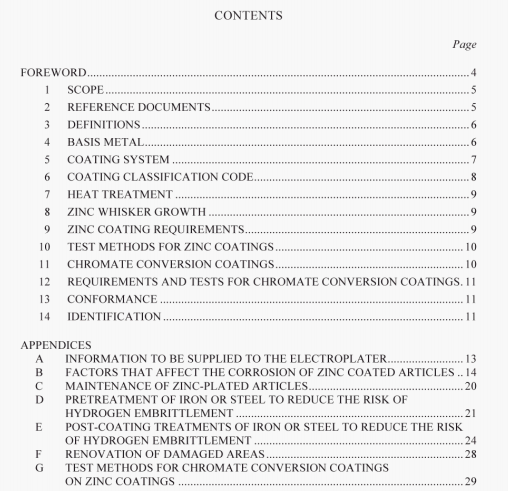AS 1789:2003 pdf – Electroplated zinc (electrogalvanized)coatings on ferrous articles (batch process).
Unless the purchaser specifies otherwise, the zinc coating shall be bright. If necessary. a specimen showing the required finish shall he supplied or approved by the purchaser.
9.2 Thickness of zinc coating
The minimum local thickness requirement of the zinc coating. as indicated by the classification code (see Table 1), or which is otherwise designated. shall apply to those portions of the significant surface that can be touched with a ball 20 mm in diameter. The minimum local thickness requirement shall also apply to additional portions of the significant surface if specified by the purchaser.
The minimum local thickness shall he determined in accordance with Clause 10.1.
In the case of articles having a significant surface area less than 100 mm2, or where the basis metal is inherently rough (e.g. from shot-peening or abrasive cleaning), the minimum local thickness shall be deetued to be the minimum value of the average thickness determined by the method specified in Clause 10.1.
9.3 Adhesion of zinc coating
The coating shall continue to adhere to the basis metal hen subjected to the test specified in Clause lO.2.
10 TEST METHOI)S FOR ZINC COATINGS
10.1 Thickness
Methods that are suitable for the measurement of zinc coatings on iron and steel are specified in AS 233l.l,l. AS 2331.1.2, AS 2331.1.3, AS 2331.2.1 and ISO 4518.
In case of dispute, the method specified in AS 2331 . I .1 shall apply, except that, for articles having a significant surface of less than 100 mm2, or where the basis metal is inherently rough (e.g. from shot-peening or abrasive cleaning), the method specified in AS 233 1 2.1 shall be used.
If agreed between the electroplater and purchaser, test method AS 233 1.2.1 may he used in all cases.
10.2 Adhesion
The adhesion test shall he in accordance with the hurnistiing test procedure specified in
AS 233 1.4.1.
II (‘HROMATF CorvF:RsIoN COATINGS
11.1 General
Conversion coatings in general, and chromate coatings in particular, enhance the corrosion resistance of elecrodepositcd zinc coatings.
Chromate conversion coatings are soft when first produced and harden with age through gradual dehydration: it is important. therefore, that coatings be handled carefully for the first 24 Ii after treatment.
11.2 Classification of chromate conversion coatings
Chroniate conversion coatings shall be classified in accordance with their chromate coating mass per unit area and with their typical appearance. as specified in Table 2.
12.2 Presence
The chromate conversion coating shall be continuous over the zinc surface.The presence ofType A coating shall be verified by the method described in Appendix G.
12.3 Adhesion
Chromate coatings shall be adherent.Coloured coatings, Types C and D, shall be tested byone of the methods described in Appendix G.
AS 1789:2003 pdf – Electroplated zinc (electrogalvanized)coatings on ferrous articles (batch process)
